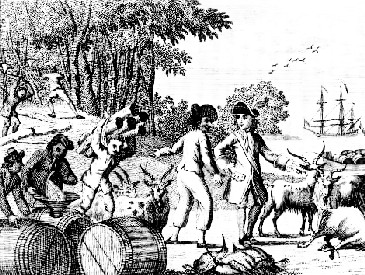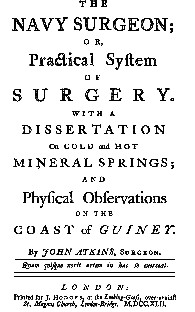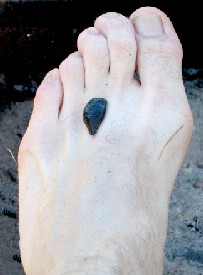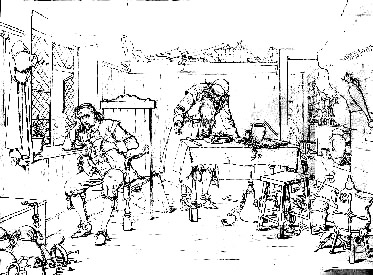
Leeches in Medicine Page Selection Menu: 1 2 3 4 5 <<First
Leeches in Medicine During the Golden Age of Piracy, Page 5
Leeches at Sea?
Now that you're five pages into the article, we come to the question I've long had about leeches: were they used by sea surgeons? I believe they may have been, but it was unlikely that they would have been used on a ship. I have a couple of reasons for this.
First, medicinal leeches are freshwater creatures and so they need to be kept in containers of fresh water. For short voyages, this would not have been a very big issue. For longer voyages, where both space and fresh water were often at a premium, it

Men loading provisions, particularly water (lower left hand corner)
"Cowley and his men taking in provisions at Juan Fernandez"
From An Historical Account of all the Voyages Round the World
Performed by English Navigators, Volume I , p. 440 (1774)
would have been more difficult to justify the effort required to keep such creatures alive for extended periods merely for the comfort of the sailors who were bled. While leeches can live for months at a time without being fed, the trouble of keeping them would have been a strong point against them.
Second, leeches were often cited as being used for children and in parts of the body where bleeding with a fleem or scalpel was not comfortable. Sailors being sailors, sensitivity does not seem to have been a big concern of theirs. In addition, operations requiring bleeding in sensitive areas like those mentioned were not the usual sort that were performed shipboard.
You might argue that the younger sailors, such as powder monkeys, could be as young as 10 or 12 years old and thus considered children. However, today's idea of how old a child was seems to be much more liberal than this time period, when boys were apprenticed around the age stated to begin their career. I suspect that when period surgical authors talk of children, they are referring to those under the age of 5 or 6.

John Atkins The Navy Sugeon
Third, only one of the period sea surgeon mentions leeches in his book: John Atkins. Atkins was a naval sea surgeon from about 1700 until 1723, but he did not write his book The Navy Surgeon until 1732 - nearly ten years after his sea practice. (Note: the edition I am using is the expanded version published in 1742.) He had been away from his sea practice for 10 years when it was first published. I have also noticed that Atkins appears to borrow quite a bit from other period surgical authors. The majority of his comments about leeches appear to closely reflect those made by Ambroise Paré and Pierre Dionis.
In fact, none of the near period manuals containing lists of items to be taken by the surgeon to sea include leeches. Woodall doesn't mention them in his expansive list of items required for the surgeon's chest (which includes items like individual candles and "Bricks to heat upon occasion".) Nor are they mentioned in the 1672 reprinting of Fabricus Hildanus' book on the military chest ("Furnished Either for Sea, or Land").
Given these points against the use of leeches at sea, I am inclined to believe they would not be a standard part of a sea surgeon's kit, especially one who intended to travel on long voyages such as those to and from the Caribbean. This doesn't mean a sailor or pirate would never have a leech used upon them, just that it is unlikely that a ship's surgeon would have access to them while he was shipboard.
1 Pierre Dionis, A course of chirurgical operations: demonstrated in the royal garden at Paris. 2nd ed., p. 476; 2 Ibid., p. 476; 3 John Atkins, The Navy Surgeon, p. 182; 4 Ambroise Paré, The Workes of that Famous Chirurgion Ambrose Parey, p.445; 5 Ibid.
Leeches as a Medical Problem

Photo: Bob J Galindo
An argument for synthetic shoes
"On the Mountains [on the way to Manila] which are very high and thick of Trees, we found such multitudes of Leeches, that there was neither means nor method of avoiding them: the Blood ran from us as we went. I declare it for a certain truth, that I saw one making its way through a Shoo; I
call'd upon others to observe that strange Sight, and they stood amaz'd at it." (Domingo Navarrete, The Travels and Controversies of Friar Domingo Navarrete 1618-1686, p. 49-50)
Not all leaches were desireable, even during this time when heroic bloodletting was widespread. Nobody wants to be inadvertently let blood while making their way into the mountains. They definitely don't want leeches eating through their shoes to get to them. (Navarette was probably describing a leech like the horse leech mentioned a few pages back that digests the skin of its host in the process of getting to the blood source rather than cutting through it like the medicinal leech. Shoes were made of leather, which is animal skin, and such a leech could probably eat through it.) Fortunately the removal of such a leech was fairly well understood as explained previously.
A more unusual problem was the swallowing of a leech. The ever-interesting Stephen Bradwell gives us such a 'leech as problem' case to consider as well as its remedy.
"Some enforced through great thirst in the heat of Summer to drink of any water next to hand, have in their greediness swallowed a Horse-Leech: which being in the throate, and finding it selfe in a place full of such food as it loved; fell to sucking of bloud there; which must needs be a great torture to the Partie. For which Accident, I finde in Authenticall Authors these Remedies following.

A Horse Leech - hard to believe you could swallow this without knowing it! Photo: Christian Fischer
The juice of Willow leaves drunk, hath the property of vexing that creature; making him let goe his hold; and so the partie, enforcing himselfe to vomit, may cast it out. Assa fætida [A rather pungent gum resin made from the stem and roots of wild fennel] dissolved in Vinegar, & the throat therewith gargled (if it be not gone downe into the stomach) will doe the like. But if it be gone downe so
low, drinke a draught of white wine wherein Garlicke is boyled. Or els, Take halfe a dram of Aloes Succotrina [a medicinal aloe plant native to sourthern Africa] powdered in a draught of white win or wormwood Beere."1
1 Stephen Bradwell, A Helps for Suddain for Accidents Endangering Life, p. 29-30
Leech as a Term for Physicians and Surgeons

"The Leech and His Patient" by Felix Octavius Carr Darley (1878)
Finally, it is worth mentioning the origin of the term "leech" as being used to describe a surgeon. This was used most popularly in the tedious book loved by English teachers everywhere: The Scarlet Letter. According to the On Line Etymology dictionary, the term actually developed separately from the little blood-eating worm we have been discussing. The OLE dictionary explains that it started out as the Old-English word læce which meant 'physician.' It was eventually merged with the word leech in MIddle English.1
It appears to have undergone some further modification in meaning based on Matthias Gottfried Purmann's comments. He explains that while bleeding is needed at times it is sometimes better to convince "People to use Moderation in their Diet and Exercise, that they may be able to consume the Super-abundance of Blood" through their activity, which "ought also to be considered by those Leeches, that are so apt to Bleed their Patients upon any trifling Suggestion". 2
1 Online Etymology Dctionary, gathered 6/4/12; 2 Matthias Gottfried Purmann, Churgia Curiosa, p. 337

